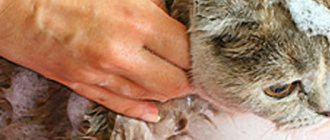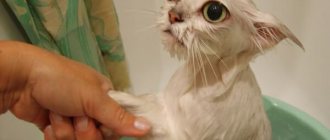All cat owners know that these are very clean animals. After eating or visiting the tray, they carefully lick their coat, and do it very efficiently.
The cat's tongue has a special structure. On its surface there are hard fibers that are located at an angle. Therefore, licking can be compared to combing with a fine-toothed comb. The cat's fur is treated with natural lubricant, which makes the fur coat attractive. When bathing, the balance is disrupted, so frequent water treatments are contraindicated for your furry pet.
Every owner understands that the animal needs to be bathed periodically, but not everyone knows how often this can be done. This procedure is recommended only in certain cases:
- in case of contamination, if the animal is walking on the street;
- once every six months to improve the appearance of the coat;
- It is necessary to bathe the cat from fleas and when infected with parasites (using special means).
But how to bathe a cat if he is afraid of water? Yes, these clean people actually have a very negative attitude towards water procedures (with the exception of some breeds). Nevertheless, sooner or later you have to resort to them. In this article we will try to tell you how to properly bathe a cat so as not to turn this process into torture for you and for the animal.
Owners need to know that the animal is accustomed to all hygiene procedures (including bathing) from a young age. Otherwise, any manipulation related to hygiene will cause a violent protest on the part of your pet.
How to bathe a cat for the first time?
So, we found out that your cat should first become acquainted with water and shampoo at a young age. It should be remembered that a kitten has a vulnerable child’s psyche. The owner’s task is not to instill in the baby a persistent aversion to water and the entire procedure as a whole. To do this, you must follow some rules. The baby’s attitude towards this procedure in the future depends on the very first bath.
A kitten should be accustomed to water from three months. Usually, before this age, his mother washes him out. However, there are exceptions to every rule. If a kitten is very dirty at the age of one month, then it can and should be bathed. You should not carry out the first procedure in the bathroom. A basin is more suitable for this, as it doesn’t look as intimidating to a baby as a huge white bathtub, and it will also be easier to keep him in the water.
You need to pour a little water so that it just reaches the kitten’s tummy. While bathing, talk to your baby in a quiet voice and call him by name. Do not wet the kitten's head from the shower; clean the fur on it with a sponge. Use shampoo for kittens, choosing it based on your pet's coat type. If you can’t purchase it, use any children’s one.
What makes cats afraid of water?
Driven by curiosity, scientists have put forward several theories to explain the causes of irrational phobia in most members of the cat family. In the course of their research, they came to the conclusion that it is not fear that motivates cats to avoid contact with water, but the instinct of self-preservation.
Cats are excellent swimmers, capable of covering long distances. A 1-month-old kitten submerged in water, for example, can swim without assistance.
Whiskered pets not only hunt well, but also swim well
Table 1. Main factors provoking fear of water procedures
| Cause | Explanation |
| Risk of hypothermia | There is an air cushion between the top layer of hair and the dermis. It absorbs heat emanating from the body and warms the pet. When wool gets wet, it loses its insulating properties. |
| Possibility of overheating | The air gap protects from overheating by preventing exposure to sunlight. For dogs, for example, to survive the heat, it is enough to breathe with their tongue hanging out. Cats that do not have this ability can only rely on a pillow. |
| Increased smell | When the fur gets wet, it gives off a strong odor and makes the animals vulnerable to large predators. In addition, such a clear cat scent complicates the hunt. The victim senses the approach of the enemy and manages to escape in a timely manner. |
| Growth of pathogenic bacteria | Wet hair absorbs more dust than dry hair. When washing, dirt enters the cat's stomach and provokes the proliferation of harmful microbes. |
Zoologists believe that cats are aware of the negative consequences of bathing and do not want to put themselves at risk. They remember at the genetic level that wet wool contributes to heat loss.
In the large family of cats there are lovers of water treatments. These include servals, tigers, Sumatran cats and jaguarundis.
Unlike cats, dogs can shake off water.
While observing the behavior of cats and dogs, researchers made another interesting discovery. Representatives of canines are active hunters. In pursuit of prey, they cover long distances. If they need to dry off, they either shake off drops of water or get rid of moisture while jogging. Fluffy pets obtain food in a less energy-consuming way. They spend most of their time in ambush, patiently waiting for prey. And they don’t know how to shake themselves off.
How to bathe an adult cat?
If you have not taught your pet to bathe from a young age, then this procedure becomes much more complicated. However, do not think that your attempt is doomed to failure. Below we will present you with tips and recommendations from experienced owners and veterinarians who will certainly answer the question of how to bathe a cat without scratching it.
To bathe an adult animal, use dry or liquid shampoos for cats; in rare cases, it is allowed to use shampoo for people, as well as baby soap.
At what age is it possible?
If your pet is very small, then you should wipe it with a damp cloth or sponge instead of giving it a full bath. Consult your veterinarian about how many months old a small kitten can be given a “full bath.” The general recommendation is to bathe no earlier than 8 weeks of age.
Cute kitten
One of the benefits of bathing your kitten at an early age is that he will gradually become accustomed to bathing as he gets older.
Cleansing with dry shampoo
This is the simplest, most gentle way. What are its advantages over the traditional one? Using dry shampoo will not make your cat nervous, and your hands will remain intact.
You can use this product once every six months. In this case, the procedure will not become more complicated than regular combing. But you should know that if it is carried out on a carpet, then it will be quite difficult to clean it from the powder. After rubbing the shampoo a little into the animal's fur, comb it thoroughly.
How often can you wash your cat?
Experts do not recommend bathing your pet unless absolutely necessary. How often you can wash domestic cats depends on the following conditions:
- Does your pet walk outside? Outdoor cats need to be washed more often than indoor cats.
- Length and type of fur. Long hair requires more care than short hair.
- Can a cat take care of its fur? For example, overweight animals have difficulty reaching all areas of the body. Because of this, the fur on the back may become tangled and the skin may begin to itch and peel.
- Activity. Active pets need more frequent bathing than sloths.
- Health problems. If an animal has skin problems, demodicosis, diarrhea, or other diseases that damage the fur, it must be bathed often. Check with your veterinarian first. For some diseases, water is prohibited.
How many times can you bathe a cat? If the pet does not participate in exhibitions, 2-3 times a year is enough, and also in case of heavy pollution.
Preparing for a swim
First of all, trim the cat's claws, this will protect your hands from deep and rather painful scratches. Brush the fur a little so that it doesn't get too tangled during bathing. This is especially important for long-haired animals. All matted wool is cut off if it cannot be untangled.
If a small amount of water is enough to bathe a kitten and you can get by with a basin, then what about an adult animal, which can sometimes be quite impressive in size? Keeping it in a small container is much more difficult; besides, it costs nothing for an adult and strong cat to turn the basin over. How to bathe a cat in the bathroom so that he doesn’t run away during a procedure he hates so much?
The first thing you need to do is protect your pet's ears. To prevent water from getting into them, put a cellophane cap on his head. Place a terry towel on the bottom of the bath so that your pet does not slip and feels at least a little more confident. There should be enough water so that it is just above the animal’s belly.
When starting to bathe your cat, turn off the water, as its noise additionally frightens the cat. Another important factor is water temperature. It should be slightly warm. Dip your elbow into it - it should not burn your skin. When bathing a one-year-old cat for the first time, you expose him to enormous stress, which will be very difficult for one person to cope with. In this case, at least two people will be able to hold it, since the frightened animal screams, breaks out, and scratches. It’s better to do this together, then one person holds the cat and the other washes it.
If you know your pet is too nervous, bathing becomes an additional challenge. In this case, how to bathe the cat? At this moment he scratches and even bites mercilessly. In this case, veterinarians recommend giving him a special cat sedative before the procedure. However, you should not abuse it.
How to bathe cats at home: preparation
Before you start bathing, prepare the bath. Place a rubber mat or towel on the bottom so that the cat does not slip and is comfortable to stand on. After washing, the floor will be wet, so place rags on the floor to absorb the water.
Draw water
Before you bring your pet into the bathroom, fill the bathtub with warm water (35‒39℃). Under no circumstances should it be hot; boiling water will not only burn the animal, but will also instill fear of washing forever. There should not be a lot of water so that the cat does not drown.
Do not run a bath in front of your pet if running water makes him nervous. In this case, collect water in large pots (tanks) in advance.
Prepare 2 towels
Leave 2 terry towels in the bathroom in advance, which absorb water well.
Wear protective clothing
Before bathing your pet, wear protective clothing. A long-sleeved shirt and pants will save you from small and large scratches. Elbow-length gloves are also an option, but they may be uncomfortable to swim in.
How is bathing carried out?
Before putting your cat in the bath, remove all unnecessary objects (towels, washcloths, jars, bottles, etc.) that he could get caught on. Prepare a towel in advance and open the shampoo. Place the cat in the bath, pet him, but hold him tightly, even if he tries to escape. These animals are very cunning, and as soon as your pet feels that your grip has weakened a little, he will immediately make a quick dash and run away.
Do not delay bathing, do not overdo it with the amount of detergents and the intensity of their rubbing. This animal doesn’t have so much fur that it needs to be dealt with in the bathroom for half an hour, and the more thorough the bathing, the more time it will take to bring the natural balance back to normal. Bathing should take no more than 5-10 minutes.
How to bathe a cat without water and shampoo getting into his nose, eyes or mouth? It’s very simple - don’t wash his face. He can handle this job himself just perfectly. Apply shampoo to the cat's back and rub it well. Stand the animal on its hind legs and apply it to the chest, belly, front legs and tail. Lather the shampoo with your hands. It is necessary to wash it off only from top to bottom, and this must be done carefully, because when the cat licks the fur after bathing, it can be poisoned by its residues. Wrap the animal in a towel and hold it in your arms to calm it down a little.
First wash
Everything ever happens for the first time. Your pet does not yet know what awaits him and may not react to the procedure the way he wants. To avoid surprises, the animal must be prepared.
Preparing the kitten and bathing area
- Brush your baby's fur; unkempt fur may become matted.
- Trim your nails to protect your hands from scratches. It is better to carry out the manipulation the day before swimming.
- Do not feed the animal 3 hours before bathing; stress is more easily tolerated on an empty stomach.
- Place a towel or rubber mat in a basin and add water. The temperature can be checked by dipping your elbow into the water. If the temperature difference is not felt, it is comfortable for the kitten.
- Open the shampoo in advance, then it will be difficult to do it with one hand.
- Prepare a dry towel.
- To redirect your baby's attention, place his favorite toy or ball in the basin.
- Calm down so that your excitement is not passed on to your baby.
Bathing products
It’s worth mentioning right away that “human” shampoos and shower gels are not suitable for a kitten. In animals, the pH of the skin is higher; products can cause irritation and peeling of the skin. Purchase a special shampoo suitable for the breed, age and coat of your pet at a pet pharmacy or store.
Taking into account the complex relationship between cats and water, shampoos are available in three types: liquid, dry and spray:
- Dry shampoos are powdered and are designed to “dry wash” without water. The powder is applied to the animal’s fur, rubbed in gently, after which the skin must be combed out. They are used in cases where it is not possible to arrange a bath, or the animal is terrified of water.
- The spray is another alternative to regular bathing. Spray the product onto the skin, massage, blot with a napkin and comb. Can be used as an express treatment and to remove individual stains. But a full bath does not replace it.
- Liquid ones are used for regular care using water. There are products for sphinxes, smooth-haired, short-haired, long-haired cats, kittens, medicinal, anti-parasitic, hypoallergenic - the choice is huge.
Professional groomers and breeders prefer Bio-Groom “Kuddly Kitty” shampoo for kittens. This is a natural product, does not contain soap, and does not irritate the mucous membranes. The only drawback is the high price.
Ms.Kiss “Fluffy Tail” hypoallergenic shampoo is a budget option that has received good user reviews. The product is specially designed for animals with allergies to conventional shampoos; it gently cares for the coat, does not irritate the skin, and does not cause itching.
The Ms.Kiss shampoo performed quite well, it provided little foam, which is undoubtedly a plus in this case, since I was afraid that it would lather into my ears, but it “shampooed” well! Just a couple of presses on the dispenser were enough to wash the entire kitten-horse, and the convexities in the shape of cat's paws along the edges of the bottle prevented it from falling out of wet hands. Since the cat behaved calmly, fortunately it was not possible to check the effect of the shampoo on the eyes! The shampoo was also washed off quite easily and quickly, no complaints here either. The aroma of the shampoo is pleasant and very, very weak, and after washing the cat smelled slightly... I don’t know what:) my wife said that it seemed like a slight smell of grass. But be that as it may, there is no rejection or oversaturation with flavors. and meanwhile the cat was diligently licking itself. After complete drying, I went over the cat with a slicker brush, combing it at the same time. He really liked this procedure, and lazily turning his sides, the prettier cat fell asleep. The shampoo coped with its duties perfectly! The fur has become very soft to the touch, fluffy, it even seems that the stripes on the cat have become more clearly visible :) So I can highly recommend the shampoo!
Andrey_BigMan
https://irecommend.ru/content/shampun-dlya-kiski-berezhno-nezhno-i-dazhe-s-konditsionerom
AVZ Shampoo “Gentle” hypoallergenic also received positive ratings from users. Contains aloe vera, allantoin, provitamin B5. Does not cause irritation or dryness to the baby's skin, gently cares for, heals small wounds, and smells good.
I had to urgently buy this shampoo for a terribly dirty kitten. He was lying on the side of the road in mud and dust up to his ears. AVZ “Gentle” shampoo for kittens photo I had to wash it very carefully, because... there was an abscess on his leg, and in general the cat was very stressed. The maximum task was to wash off the dirt at least a little, but I was pleased with the result! The shampoo lathers well and washes off without any problems. The consumption is normal, there is no need to pour the animal from head to toe. I won’t say anything about the composition, I don’t understand it, unfortunately. It cost around 100 rubles. The cat has been living with me for a couple of months now and, I must say, he is such a mop! Recently it got so bad that I had to “wash it out” again. The positive impression was strengthened. The wool is soft and crumbly. The cat shows no signs of discomfort.
abdurda
https://irecommend.ru/content/khorosho-moet-deistvitelno-nezhnyi
“Clandestine” lives up to its name - it gets rid of fleas and ticks. Smells pleasant and contains caring oils. Foams well and rinses off well, does not cause irritation. It has also received good reviews from small pet owners.
A year ago we got a new “family member”, the little cat was named Bonya) And of course, before taking her to my home, I decided to buy everything she needed, this list included shampoo, to be honest, the company wasn’t particularly important to me and the price. The choice at Auchan is not particularly large, so I bought this shampoo because I liked the smell. The kitten was delivered, about a month passed and I finally decided to take her to her first water treatment) The shampoo foams well in the hand, and it rinses off well and quickly) After it, the fur is soft and smells delicious)) A little advice from me: if you start bathing cats from 2-3 months, then later she will take the bathing process for granted, it even seems to me that she likes it!) Overall good, budget shampoo for kittens, so if you have a choice whether to buy it or not, then definitely YES!))
ksenia999
https://irecommend.ru/content/kuplyu-eshche-razfoto-shampuni-i-chistoi-koshechki
If your baby has insects, use anti-parasitic shampoo, which can be bought without a prescription. Wash an animal you picked up on the street with this shampoo; it almost certainly has parasites. If you have skin diseases, consult your veterinarian, he will recommend a suitable remedy.
Let's move on to water procedures
- Bring the kitten into the room in your arms, stroking it and talking to it quietly. Do not squeeze too hard, do not twist the paws, do not cause pain or discomfort.
- Take your time, place it in a container with water, let it get used to a little. Hold firmly with one hand if the animal breaks away.
- With your free hand, scoop up water and wet the fur, while stroking the baby. The head should be dry.
- Apply a small amount of shampoo and spread over the skin.
- Lather the shampoo with massaging movements, rubbing it into the coat. Start from the back, gradually moving to the stomach, chest, and legs. Pay special attention to the groin and butt, as dirt most often accumulates there.
- Now you can wash your hair. Using your palm or sponge, wet the area between the ears first, then the chin. Avoid getting water in your ears, nose and eyes.
- Distribute the foam from your back and chest onto your head and massage.
- Using your palm to collect water from the basin, rinse off the foam.
- Rinse the fur. Don't open the tap too much; most cats are afraid of the sound of running water. If your baby panics, rinse the shampoo in a bowl of clean water or pour it from a ladle.
- Repeat until the water stops lathering.
- Lightly squeeze out the water with your palm and wrap your baby in a towel.
Advice! Do not delay bathing; the water should not cool down until the end of the procedure.
Video: how to wash a kitten for the first time
How to dry wool properly
The main task is to dry the coat so that the baby does not get cold or catch a cold. In hot summer weather there is nothing to fear; wet wool will dry in the open air. If this happens in winter, the room should be warm; wet wool dries completely in 12 hours.
Wait until the water is absorbed into the towel, and if necessary, change it to a dry one. There is no need to wipe, wet wool is fragile and easy to damage.
Whether to blow dry or not, decide based on your pet’s reaction. It is better not to do this during the first bath; the baby gets enough stress from bathing. It is better to free the kitten from the towel and place it in a warm place.
The hair dryer is recommended to be used only for long-haired animals and in preparation for exhibitions. In this case, the temperature should not exceed 40°C; keep the hairdryer at a distance of 30 cm.
Let your pet finish what he started by licking his fur. After this, the kitten can be combed.
Flea shampoo
When keeping a cat, great attention should be paid to the regular extermination of fleas. For adult animals, this is much easier to do than for a kitten: you can wear flea collars or use external drops once a month. But such products are not recommended for use on kittens - for them, the dose of chemicals may be toxic.
The most practical and most effective way to rid your baby of fleas is to bathe him with a special shampoo. Depending on the strength of the shampoo, the animal may need to be re-treated. As a rule, clear recommendations are indicated on the packaging of the product. Remember that you should not wash your cat for no apparent reason. She should only be bathed if she is really dirty.
How to wash representatives of different breeds
Some types of cats require an individual approach to hair care. For purebred pets, it is advisable to use specialized shampoos. White animals require the use of bleaching detergents. Long-haired babies, Persian and Siberian for example, are bathed more often than others, once every 2 months. Shorthaired Scots or British - once every 6 months.
Persian kittens are bathed more often than others
Features of bathing sphinx kittens
Hairless pets differ from their counterparts not only in their exotic appearance, but also in the rate of contamination of the skin. Due to the fact that they do not have a protective coat, they need to be bathed frequently. Veterinarians recommend washing hairless kittens once every 3-5 weeks. For water treatments, Ms.Kiss “Graceful Sphinx” and Doctor VIC shampoos are suitable. To clean your pet's head, you need sanitary napkins specially designed for cats.
Sphynx cats sweat a lot. This leads to excessive contamination of the skin, especially in the folds.
The skin of Sphynx cats gets dirty faster than other breeds.
Bathing a kitten is a responsible and energy-consuming procedure. Knowing the basic rules of a bath day, this process can be turned into an exciting event. A pet’s love for washing largely depends on the owner, so you should patiently instill in your baby a culture of water hygiene.
What should you not do while swimming?
As you can imagine, bathing a cat, a procedure that takes only a few minutes, is quite difficult for both the animal and its owner. Therefore, it is necessary to minimize possible irritants:
- Do not open the tap at full capacity.
- The shower should not be turned on at full power.
- Do not use dog shampoo or dishwashing detergent to wash your pets.
- There is no need to pour shampoo from the bottle directly onto the coat, especially dry hair.
- It is strictly forbidden to stuff the animal's ears with cotton - it can cause serious irritation.
Which shampoo to choose and what can you replace it with?
There are a huge number of shampoos for cats. So huge that the list and description alone would take up the entire article.
Shampoos are only hygienic (designed to wash away dirt from your pet’s fur coat), specialized (tinted, designed for dry, oily hair, for washing cats without hair, from tangles) and medicinal (antibacterial, eliminating dandruff, allergies, against ringworm), as well as insecticidal (against lice, ticks and fleas).
If you have a Sphynx cat, you can only wash it with a specialized shampoo. Regular ones are not suitable for hairless cats. They can cause dermatitis. Therefore, if the necessary shampoo is not on sale, it is better not to bathe such a cat at all, but to wipe its delicate skin with a damp cloth.
In addition, shampoo can be liquid, spray or dry.
Traditional liquid shampoo is used for bathing cats that are already accustomed to water treatments.
Dry, as the name implies, is suitable for those who, at the mere sight of a bowl of water, disappear under the bed and flatly refuse to come out. It will help tidy up the animal's fur in winter, when ordinary bathing can result in a cold. Of course, it won’t cope with heavy pollution, but it’s still better than nothing.
Waterless shampoo sprays, in addition to their usual functions, have an antistatic effect. True, not all cats adequately tolerate the characteristic hissing; many are frightened by this sound. Therefore, spray shampoo is recommended for balanced cats with a strong nervous system.
A bottle of regular shampoo for cosmetic purposes should always be in your cat care arsenal. But if it is not there, and the cat urgently needs to be washed, you can use shampoo intended for the smallest children. It does not sting the eyes, does not dry out the skin and will not cause any harm to your pet.
All other human shampoos are not suitable for cats. They can cause poisoning and do more harm than good.
If there is no other remedy, you can wash the cat with simple laundry soap. It doesn't act as delicately. But if your pussy, among other things, has picked up fleas, soap will deal with them in no time.
What to do after swimming?
After bathing your cat, you need to dry it thoroughly with a towel, since cats get very cold after such a water procedure, especially if the apartment is not very warm. Many owners consider it lucky if the cat allows him to be warmed in a towel for at least five to ten minutes. Then the animal will most likely break free and begin to lick its coat on its own.
Pre-cover all surfaces where your pet can sit down to lick with towels. They will absorb moisture, and your sofas and carpets will remain stain-free. If your cat continues to tremble violently within five minutes, try to dry it with a hairdryer to avoid catching a cold or even pneumonia.
You already know how to bathe a cat. Now it’s worth talking about combing the fur. When the cat stops licking his fur, pick him up and brush him with a wide-toothed brush. After bathing, the coat becomes very brittle, so combing must be extremely careful.
Should I bathe my cat?
Cats are afraid of water, so bathing is a serious stress for them. By regularly licking and washing, cats keep their fur clean. However, in some situations it is necessary to bathe a cat:
- If the wool is very dirty;
- The animal was found to have parasites;
- The cat got dirty in toxic substances, such as fuel oil;
- During the molting period, to remove dead hairs.
Washing is additional hygiene for the animal, prevention against parasites, softening and moisturizing the skin, removing lost hair, and simply maintaining the aesthetic appearance of your cat. Therefore, every owner needs to know how to bathe a cat correctly.
How often to bathe a cat
It depends on his lifestyle. On average, a cat requires 5-6 baths per year.
Regular bathing is inevitable for show animals, as their fur is evaluated very carefully. Hairless cats need to be washed frequently because they sweat through their skin. Long-haired dogs are bathed so that less hair falls out.
Kittens should be bathed no earlier than three months of age. Water procedures for small kittens can lead to hypothermia and the baby catching a cold.
And a few more tips
- Under no circumstances should you yell at your pet while bathing; remember that he is under extreme stress; calm him down in a quiet voice.
- Rinse the fur very thoroughly after shampoo - low-quality products can be toxic to the animal.
- If the cat gets dirty with something oily, lubricate the spot with butter before bathing, massage it a little and blot it with a paper napkin or towel.
- When removing fleas using a special shampoo, first wet its neck so that they do not run onto the animal's head.
When swimming is contraindicated
As you know, cleanliness is the key to health. But there are times when water treatments need to be postponed.
- First of all, focus on the animal’s well-being; if the kitten is sick, you cannot wash it.
- Unhealed wounds on the skin are another reason to postpone the procedure.
- After vaccination, the animal cannot be bathed for two weeks, after castration - for 10 days.
- Age under four weeks is a relative contraindication.
- If a kitten did not come into your home from the street, you can bathe it only after three weeks of adaptation.
- But for shingles, bath procedures are welcome.
If you carry out the first procedure carefully, without damaging the delicate mental organization of your pet, subsequently bathing will not cause negative emotions in him. And perhaps he will even love to swim. And then keeping your pet clean will not be a problem for you.
Bathing a cat before a show
Before participating in the exhibition, any domestic cat will have to be washed. Such bathing will have some features:
- You need to wash the cat twice before the exhibition; during the second wash, use a tinted shampoo (or balm) selected depending on the color;
- the foam is also washed off 2 times, first with water, then with a rinse aid or a weak solution of vinegar;
- while drying with a hairdryer, the wool is smoothed with a massage comb with antistatic teeth, starting from the back and ending with the collar;
- Now you can apply powder to the still slightly damp “fur coat”, which will absorb the remaining moisture and make the coat smooth;
- After a couple of hours, finish treating your cat's fur by applying a protein conditioner.
Life hack: how to choose a tinted shampoo for cats of different colors
White pets are washed 2 or even 3 times with shampoo intended for white cats. When reapplying, leave the shampoo on for 2 minutes for a deeper effect, and then be sure to rinse well. White shampoo is also suitable for chinchilla and silver marbled cats, but there is no need to leave the detergent on the coat. If a cream, blue or lilac cat seems a bit dark to you, use the same shampoo to create a lighter, brighter shade.
Cats with rare red, tortoiseshell and merle colors should be washed with red or bronze shampoo. If your cat has a chocolate-colored coat, add a few drops of black to the bronze shampoo. Black shampoo is suitable for fluffy beauties of black colors.
Follow the instructions, and your cat will outshine all its relatives at the show!











